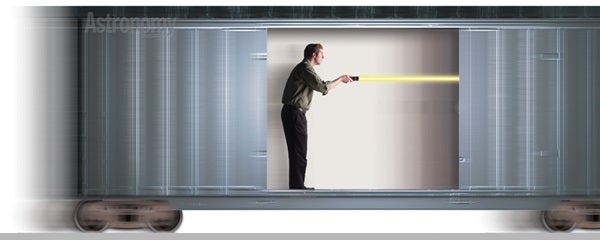This question gets to the heart of the special theory of relativity. Let’s take a simpler example to start with. Imagine someone standing on a moving railroad car and shining a flashlight. What is the velocity of that beam as seen by someone on the ground? According to the laws of physics instilled by Isaac Newton and Galileo Galilei, the person on the ground would just add the velocities of the car and the beam, and would see the beam moving faster than the speed of light.
But we don’t live in that world, as Albert Einstein showed in 1905. In our relativistic world, moving clocks slow down and moving objects shrink in the direction of motion. Because the definition of velocity is the change in distance divided by the change in time, it should come as no surprise that the addition of velocities is more complicated for Einsteinian physics than it was for Newtonian physics. In the above example, the light’s distance has shortened and its clock has slowed. Thus, both the person on the railroad car and the onlooker see the beam moving at 186,282 miles per second (299,792 kilometers/second) — the speed of light.
But we don’t live in that world, as Albert Einstein showed in 1905. In our relativistic world, moving clocks slow down and moving objects shrink in the direction of motion. Because the definition of velocity is the change in distance divided by the change in time, it should come as no surprise that the addition of velocities is more complicated for Einsteinian physics than it was for Newtonian physics. In the above example, the light’s distance has shortened and its clock has slowed. Thus, both the person on the railroad car and the onlooker see the beam moving at 186,282 miles per second (299,792 kilometers/second) — the speed of light.
The same thing happens with the protons in the Large Hadron Collider. If you could somehow sit on one proton and measure the speed of the approaching one, you would see it moving toward you at nearly the speed of light (technically, 0.999999991 percent of light-speed).
These relativistic kinds of effects become important only for objects moving at nearly the speed of light. For ordinary speeds, Newton’s and Galileo’s rules work just fine.
James Trefil
George Mason University,
Fairfax, Virginia
George Mason University,
Fairfax, Virginia










